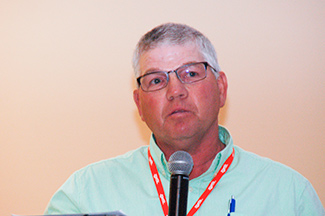Timed AI with Sexed Semen
As part of a well-managed breeding program, split-time AI can help narrow the difference between pregnancies achieved with sexed vs. conventional semen.
by Troy Smith, field editor
BROOKINGS, S.D. (June 18, 2019) — “With any mating, one sex of calf always has more value than the other. It depends on the particular operation’s marketing program, but there is always a value difference. One sex is worth more than the other,” said Jordan Thomas, a University of Missouri reproductive physiologist, during the National Association of Animal Breeders (NAAB) Symposium, hosted in conjunction with the 2019 Beef Improvement Federation symposium in Brookings, S.D.

Jordan Thomas
Using split-time AI allows anestrus females more time to express estrus prior to insemination, allowing a better total estrous response and an improved pregnancy rate,” said Jordan Thomas, University of Missouri reproductive physiologist. Group pregnancy rate can be increased 5%.
According to Thomas, that value difference drives producer interest in artificial insemination (AI) strategies involving sexed semen to target bull calves only or only heifers. Sexed semen does allow for choice of calf gender, but its use also involves extra costs. The price per straw is higher than for conventional semen, it’s not available for every AI sire, and pregnancy rates often are lower than with conventional semen.
Heat detection is recommended prior to insemination with sexed semen, since optimal pregnancy rates are achieved when females are fully expressing estrus at the time of insemination. That has hindered use of sexed semen for timed AI — an estrous synchronization strategy that eliminates heat detection by preparing a group of females for mass-breeding at a predetermined time. The hinderance is due to the portion of females not fully expressing estrus at the time of insemination. If too much time passes between mass insemination and the time these females actually ovulate, sexed semen may no longer be viable.
Thomas told the symposium audience that a potential solution is application of split-time AI. This approach involves sorting females synchronized for AI into two groups. Females fully expressing estrus are inseminated at the prescribed time, according to protocol. Insemination of the other group, containing non-estrous females, is delayed until 20-24 hours after the protocol-prescribed time.

Brent Mason
(goes with Jordan Thomas presentation)
Brent Mason, of Frankfort, SD, shared his practical experience applying split-time AI to improve overall pregnancy rates following insemination with sexed semen. Mason-Knox Ranch’s use of gender-sorted semen targets heifer calves, resulting in a large pool of half-sisters from which to choose replacement females.
“This allows the non-estrous females more time to express estrus prior to insemination. We get a better total estrous response and an improved pregnancy rate,” said Thomas, explaining that pregnancy rate for the total group typically increases by 5% or more with application of split-time AI.
Thomas noted, however, that results of split-time AI have been most consistent for heifers and more variable for mature cows. Also, application of split-time AI involves an additional sorting process, which may be more challenging when applied to cows with calves.
Thomas said use of split-time AI, as part of a well-managed breeding program, can help narrow the difference between pregnancies achieved with sexed vs. conventional semen. When results with sexed semen are comparable to conventional semen, Thomas would expect more commercial producers to adopt AI and breeding programs differentiated on the basis of maternal and terminal emphasis.
The 2019 BIF Annual Convention was hosted by South Dakota State University and the South Dakota Beef Breeds Council June 18-21 at the University Comfort Suites and Convention Center in Bookings. ANGUS MEDIA® provides comprehensive online coverage of the event at www.BIFconference.com. Visit the Newsroom for summaries, proceedings, PowerPoints, video and/or audio of the sessions and the Awards page for announcements and photos of award winners.
Editor’s Note: This summary was written under contract or by staff of ANGUS MEDIA®. Through an agreement with the Beef Improvement Federation, we encourage reprinting of the articles to those who will adhere to the reprint guidelines available on this site. Please review those guidelines or contact Shauna Rose Hermel, editor, at 816-383-5270. PowerPoints are posted with permission of the presenter and may not be reproduced in whole or in part without the express permission of the presenter. We welcome educational venues and cattlemen to link to this site as a service to their audience.
For questions about this site, or to notify us of broken links, click here. Look for additional coverage in the Angus Journal, the Angus Beef Bulletin, the Angus Journal Daily, the Angus Beef Bulletin EXTRA and Angus TV.


